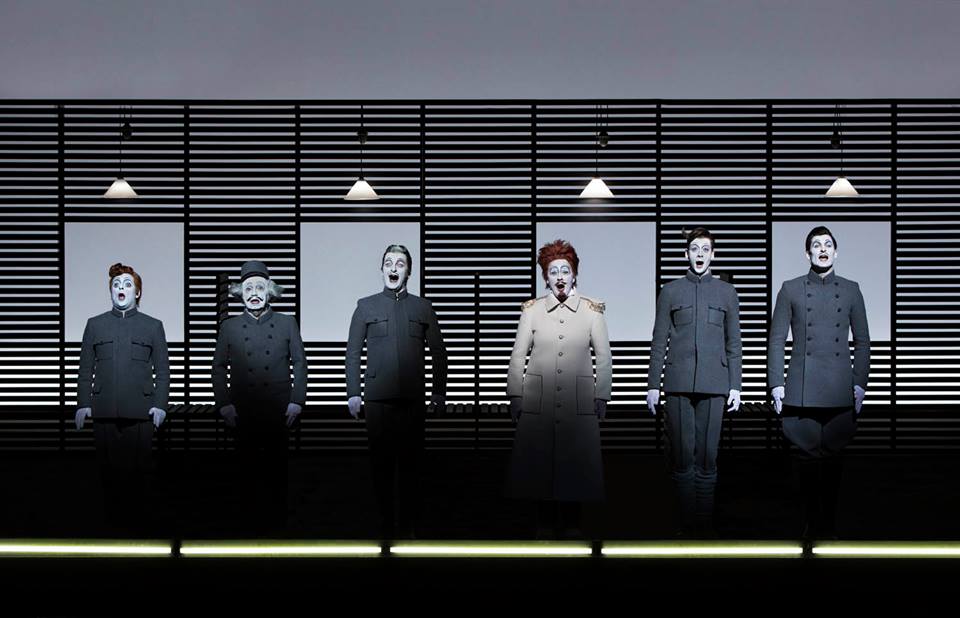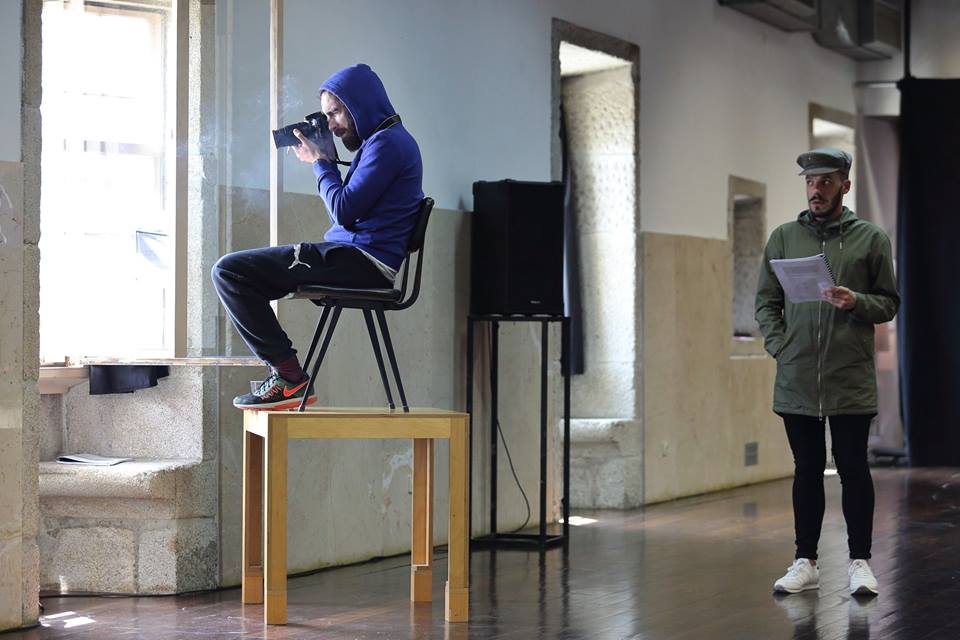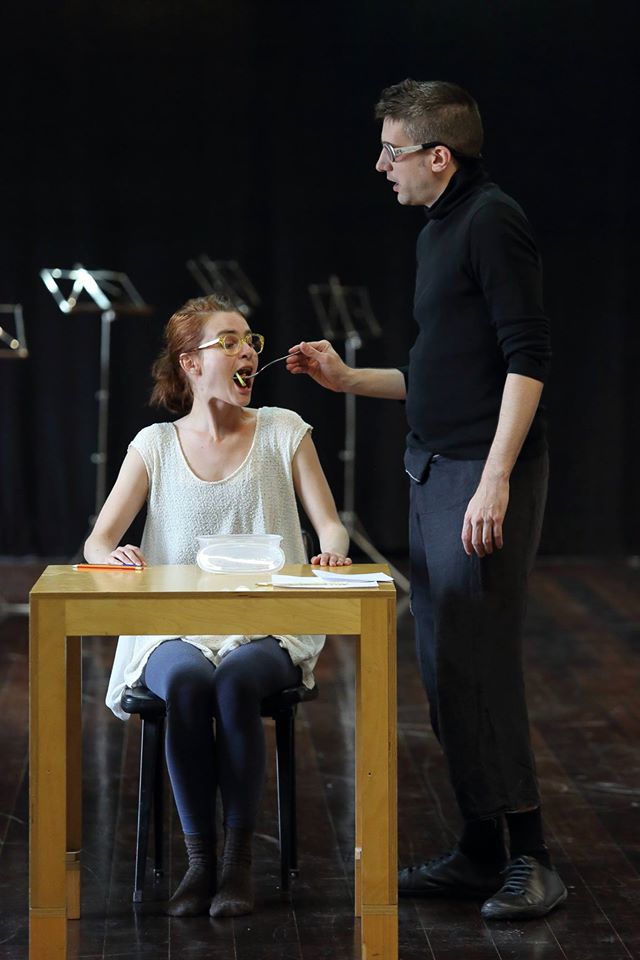ISO Theatre – Porto 2016:
Krausian Satire as well as a Cabaret Slapstick
Between 22 and 31 May, 2016, one of the ISO Theatre (International Super Objective Theatre – the group name is an allusion to Stanislavsky’s notion of super-objective) meetings took place, this time in collaboration with the Portuguese National Theatre São João in Porto (Teatro Nacional São João do Porto).

The ISO Theatre Group was established in 2012 under the auspices of the UTE (Union of European Theatres/Union des Théâtres de l’Europe) as a spontaneous response to the masterclasses, organized by the UTE Decentralized Academy. One of the first masterclasses was held in November 2012 in the Little Drama Theater in St. Petersburg (Малый драматический театр / the Maly Drama Theatre) under the guidance of Russian director Lev Dodin.
The idea of both interconnected projects – the ISO Theatre and the UTE Decentralized Academy – is based on the principle of creative exchange and sharing of experiences in the context of the tradition of European theater aesthetics and anthropologically oriented theatre discourse of contemporary Europe. The collaboration of both platforms is carried out within the network-programme of the UTE called Conflict Zones, which is supported by the Creative Europe Programme of the European Union).
The 2012 emergence of the ISO Theatre was articulated in A European Youth The ISO Manifesto, in which the artists formulated their pan-European ideological and artistic vision. At the birth of the ISO Theatre stood several young theatre practitioners from six European countries and Israel. Over the past four years, the group has undergone slight changes, and the solid core of the company was formed. Currently, the group consists of eight member countries (Bulgaria, France, Germany, Poland, Portugal, Romania, Greece and Israel/Palestine).
In Porto, the ISO Theatre group worked under the leadership of Nuno Carinhas, the artistic director of the National Theatre São João, Porto, and the Lisbon-based director Nuno M. Cardoso. The basis of the week-long workshop was the dramatic opus magnum written by the Austrian satirist, essayist, journalist, performer and, above all, visionary Karl Kraus (April 28, 1874, Jičín, now Czech Republic – June 12, 1936, Vienna): The Last Days of Mankind (first published as a series in K. Kraus’s journal Die Fackel – The Torch between 1918–1919)
Kraus’s Destruction of the World in the Black Magic of Wikisources and Postmodern Totality of Global Phrases
Karl Kraus wrote his Last Days of Mankind, a dramatic oeuvre in five acts with prologue and epilogue, between 1915–1918/19, i.e. in a close connection with the war events, which Kraus reflected in the work with his symptomatic, docudramatic satire.
Documentary character of this text lies in two aspects: (1) the text material is imbued with concrete, “annexed” reality of wartime events; (2) Kraus’s then heretically original artistic practice based on the dramatic montage of anonymous quotes from newspapers, war reports, proclamations of political and army officials or individuals representing cultural and artistic elites, as well as the speech patterns and phrases appropriated from the everyday, mostly Viennese, street life. The linguistic material, which drew on a wide array of contemporary public life and especially from its media discourse, provided Kraus a pre-text which he quite loosely assembled into a distinctive collage. However, the quoted anonymous excerpts remained literally faithful to the original. Needless to say that the statements of an endless line of characters, i.e. “mankind,” are either verbatim or loose quotes expropriated from the speeches of concrete individuals who are subjected to Kraus’s satirical subversions.
Noteworthy is also the structure of Last Days of Mankind, which converges the aesthetic convention of traditional dramatic form (five acts with prologue and epilogue) with the characteristic modernist practices (montage or juxtaposition of separated elements). In this context, Kraus with his original creative approaches (in the Last Days of Mankind e.g. a method of documentary citation) can be considered a direct predecessor of theatre of absurd or postmodern, documentary and post-dramatic theater.
Symptomatic of all of Kraus’s work, including the Last Days of Mankind, is its affinity with the philosophy of language, namely Ludwig Wittgenstein (see e.g. JUST, Vladimír. Valpružiny noci Karla Krause. Divadelní revue 25, 2014, č. 2, s. 104–130). One of the dominant features of the Last Days of Mankind is Kraus’s essential belief that the acts of concrete violence, the structure of power mechanisms and principles of totalitarian manipulation grow from automatisms of linguistic clichés or the anonymous “tyranny of public phrases” (ČAPEK, Karel. Spisy. Od člověka k člověku III. Praha: Čs. Spisovatel. 1991, s. 173). In the context of philosophy of language, Kraus’s documentary-citation method, which is the cornerstone of the Last Days of Mankind, seems to be a logical outcome of the artist’s ethical and philosophical convictions. Characteristic of Kraus is his particularly sharp criticism of not only public populism, superficial journalism, nationalism in all its forms, but, above all, media strategies per se.
In one of his texts, entitled The End of the World Through Black Magic (1922), Kraus did not hesitate to call journalists “modern-day vampires who feed on ink instead of blood ” (qtd. in JUST, V. Ibid., p. 112) [The title of this subchapter is an allusion to Kraus’s text]: “Newspapers exterminate all imagination: explicitly in the way they offer reality with fantasy, while protecting the receiver from his activity; indirectly by anaesthetizing his ability to perceive art […] The poet will no longer exist, substituted by the reporter; and the state lacks the imagination to introduce the very last tax which would be a kind of starting point and a kind of honest attempt at pounding the capital out of spiritual misery: phrase tax.” (Kraus, K. Soudím živé i mrtvé. Praha: Odeon, 1974, s. 219–220) In this sense, Karl Kraus anticipated the subsequent development of critical thought about the media discourse. It is hard to say how would Kraus reflect the current mediatized world, dominated by global, television, and internet strategies.
In the Last Days of Mankind, Karl Kraus expressed his anxiety about political events and their mediatized image which is in our tradition “inscribed” in history: “In this time you should not expect a single word from me. Besides: The only protection from the misinterpretation is silence. […] Those who have nothing to say, keep talking. Let him who has something to say come forward and be silent.” (KRAUS, Karl. Aforismy. Přel. Aloys Skoumal. Divadlo 15, prosinec 1964[a], č. 10, s. 28.).
Kraus’s words resonate with Ludwig Wittgenstein’s letter to Ludwig Ficker: “My work consists of two parts, the one presented here plus all that I have not written. And it is precisely this second part that is the important point. […] In short, I believe that where many others today are just gassing, I have managed in my book to put everything firmly into place by being silent about it.” (Wittgenstein qtd. in Janik, see link)
The afore-mentioned quotes capture the intellectual and aesthetic essence of Kraus’s Last Days of Mankind more eloquently than any detailed description of this vast, almost 800 pages long work that stages an apocalyptic and deliberately de-individualized vision of destruction and decay of European civilization against the backdrop of the First World War.
Besides his literary-satirical, essayistic and journalistic activities, Kraus organized his own public lectures within which he also performed (Kraus was also an actor and cabaret artist in his early youth). The format of lectures was rather syncretic, fusing authorial readings with stand-up and performance art. However, the topicality of Kraus’s theatrical and dramatic legacy, which inspired e.g. Austrian actor Helmut Qualtinger, in the context of contemporary European dramaturgy remains virtually undervalued. It is only in the German-speaking countries where, every now and then, an adaptation of the Last Days of Mankind occurs.
In this context, Robert Wilson’s controversial Prague production of 1914 should be mentioned. The script of 1914, which premiered in April 2014 at the Prague National Theatre under the auspices of the CONFLICT ZONES network-programme of the UTE, is based on Marta Ljubková and Robert Wilson’s adaptation of Kraus’s Last Days of Mankind and the satirical novel The Good Soldier Švejk (1921–1923) written by the Czech writer Jaroslav Hašek. 1914 was the second attempt at the stage adaptation of Kraus’s play in the Czech Republic.

Historically the first (and essentially the only) Czech production of Kraus’ work, presented as Last Moments of Mankind, was mounted by the Prague Chamber Theatre at the Theatre Comedy, Prague (prem. 2011).
(Last Moments of Mankind. Kraus, Karl – Schmitt, Katharina – Zielinski, Thomas – Riemenschneider, Alexander – Bárta, Vojtěch – Knotková, Viktorie. Director: Schmitt, Katharina – Zielinski, Thomas – Riemenschneider, Alexander, prem. April 22, 2011, Theatre Comedy.)
ISO Theatre Inquiry into the Fourth Act of Kraus’s Apocalyptic Vision
The artistic residency of the ISO Theatre in Porto united seven members of the group: Bilyana Georgieva (Bulgaria), Khwala Ibraheem (Israel/Palestine; participated in the final stages of the residency), Boris Krastev (Bulgaria), Vincent Menjou-Cortès (France), Luís Puto (Portugal), Kim Willems (Germany) and Angélique Zaini (France). Rehearsals/masterclasses were conducted under the leadership of Nuno Carinhas and Nuno M. Cardoso and took place on the premises of the former Benedictine monastery Mosteiro Sāo Bento da Vitória, whose significant part has been utilized by the National Theatre São João, Porto Teatro Nacional São João do Porto, TSNJ) for alternative and chamber-like events for which this space offers appropriate conditions that can’t be provided by the traditional proscenium arch stage of the historical building of the TSNJ.
For the purposes of the masterclass, directors Carinhas and Nuno M. Cardoso selected the fourth act of Kraus’s Last Days of Mankind. In the first stage of the masterclass (May 23 – May 27) the performers worked on collective improvisations which were based on the fragments from the fourth act. The final outcome of the workshop was presented as a “work-in-progress” in front of an audience, consisting of an internal member circuit of the TSNJ and invited trainees of the CONFLICT ZONES network-programme of the UTE, namely Elena Galanopoulou (cultural journalist, Greece), Julie Kočí (historian of ballet and dance theater, Czech Republic) and Sergio Lo Gatto (theater critic and cultural journalist, Italy).
The final presentation, which was conceived as an informal, open and uninterrupted rehearsal, included nine improvised scenes from the fourth act of the Last Days of Mankind (scene 11, 12, 13, 14, 22, 32, 34, 38 and 39). The actors performed on a bare stage, coated with the vinyl dance floor material, the backstage was separated by a black curtain. In the front left side of the stage there was an ordinary worn-out wooden table and chairs. In several improvisations both pieces of furniture were employed in a variety of ways. Among other items that have appeared on the stage were e. g. camera, pen and paper, paper bag (designed for pastry) or a plastic box filled with a leftover from lunch, or fork. All props, as well as “costumes” were fully authentic objects of everyday use. The ordinary-like authenticity of improvised fragment was disrupted by the articulated aesthetic interpretation only once and for a few moments: at the end of scene 13, which is in Kraus’s play a grotesque demonstration of anonymous brutality, embodied in the violent act of a male nurse assaulting a wounded, groaning soldier; in the spirit of Kraus’s bitter poetics the scene leads into the saucy pub ditty that drowns the moans of the dying soldier. In the presentation, the pub ditty was substituted with Ravel’s Bolero.
The open rehearsal revealed the precise work of both directors who prepared the workshop and presented fragment, powerful presence of some performers and diversity of acting and cultural traditions of ISO Theatre members.
Carinhas and Nuno M. Cardoso approached the ISO Theatre residency, whose contribution already lay in the dramaturgical selection of Kraus’s play, both pragmatically and highly empathically, respecting the linguistically and culturally disparate nature of all participants, as well as the complicated structure of Kraus’s text. Both directors were very well aware of the linguistic, aesthetic and philosophical complexity of Kraus’s vast work, and, hence, were very well aware of the complex difficulties related to the linguistic, as well as meta-linguistic translation of the text within the framework of a 4–5-day workshop.
Thus, the major objective of their concept of the ISO Theatre residency was not unifying an aesthetic idea of Last Days of Mankind or an abstract interpretation of the work, but the principle of a collective experience of the text which – under the satirical reflections of media discourses related to the recent war history of Europe – conceals a profound anthropological experience of European civilization.
ISO Theatre Dramaturgy: A Search for the European Theme in the Jumble of Judeo-Christian Tradition (Bible) – Anthropological Pretext of Ancient Tragedy (Oresteia) – and in the Chaos of Life-style Clichés or Guidebooks of Contemporary Global Discourse
The group dedicated the last three days of ISO Theatre residency in Porto to the debate on the possible dramaturgical and operative concept of the future project which could be implemented either on the principle of a collective-laboratory creation, or in collaboration with a director. An organic, at times dramatically tectonic, debate predominantly addressed the issue of dramaturgical choices. Unequivocal consensus prevailed regarding the conceptual vision of ISO Theatre dramaturgy, which should focus on pan-European themes presented in a perspective that would resonate with the dynamic nature of controversial notions (or clichés?), such as “Modern Europe” – “contemporary European” – “contemporary European society” and its culture…
The outlined dramaturgical-conceptual collective process crystalized in the discussion of three fundamental materials that reflect the shared cultural-anthropological legacy of the European tradition, as well as the complexity, brutality and volcanic controversy of historical continuity of European civilization. The group discussed the Bible and the Aeschylus’s Oresteia; another topic was the global media format of guidebooks, cookbooks or instruction manuals, approached with a sense of biting irony and grotesqueness.
The satirical inversion of current not only European but global media discourse that corresponds to the Last Days of Mankind seems to be an eloquent reminiscence of Kraus’s message for the contemporary globalized European civilization, under whose ruins the embers of myths of collective origin still smoulder and the stigmata of both ancient and recent conflicts keep bleeding.
At a time when spectres once again are haunting Europe, spectres which cast far-reaching shadows of past guilt – a warning memento for the future – we, Europeans, probably have no other alternative but to choose between a postmodern-discursive analysis of our cultural memory embedded in the post-dramatic, fragmentary forms, or remain silent in the Krausian–Wittgensteinian manner.
“Under the white walls a mud in pearl-sheen
and after the wind bells flew to Rome,
horizon blushes, my dad,
scarlet in shame
we’re here alone, no descent from the cross.
Languid battalions already burning hands of bearers,
perhaps under the helmet only eyes hope
[…]
Not a piece of cake to drink again a heaping glass of wine
And believe in prophets in the chorale of bungle,
Dark hundred years shine with the star of poison
On the coat of arms for slaves – our heirs.”
(Karel Kryl, a fragment from the song White Mountain/Last Moravian.)
The quoted lyrics of Czech poet and songwriter Karel Kryl (April 12, 1944, Kroměříř – March 3, 1994, Munich) — who in 1969 left communist Czechoslovakia for West Germany, where, among others, he co-operated with the exile Radio Free Europe — express better than any other word the bitterly painful experience of this post-war (East- and Central) European artist who, like a few generations before him the (Central-) European Kraus, did not and could not remain silent. Kryl’s song is an allegorical protest against the occupation of Czechoslovakia that followed the invasion of Warsaw Pact troops in August 1968. The lyrics, however, strictly correspond with the historical facts related to the Battle of White Mountain, an early battle in the Thirty Years’ War fought on 8 November 1620, in which an army of 15,000 Bohemian estates and mercenaries were defeated by 27,000 men of the combined armies of Ferdinand II, Holy Roman Emperor, and the German Catholic League. The battle marked the end of the Bohemian period of the Thirty Years’ War, and decisively influenced the fate of the Czech lands for the next 300 years.
Kryl’s reference to the monstrous reality of the Thirty Years War and his immediate allegory of his own experience with the demonstration of Soviet totalitarian power, as well as of his own awakening to the reality of active collaboration of Czechoslovak political representation, which was accompanied with the passivity of a majority of Czechoslovak population, is a telling postscript to Kraus’s artistic reflection of European totalitarianisms through the poetics of phrases, shibboleths, and media clichés.
Published on 29 June 2016 (Article originally written in Czech)



